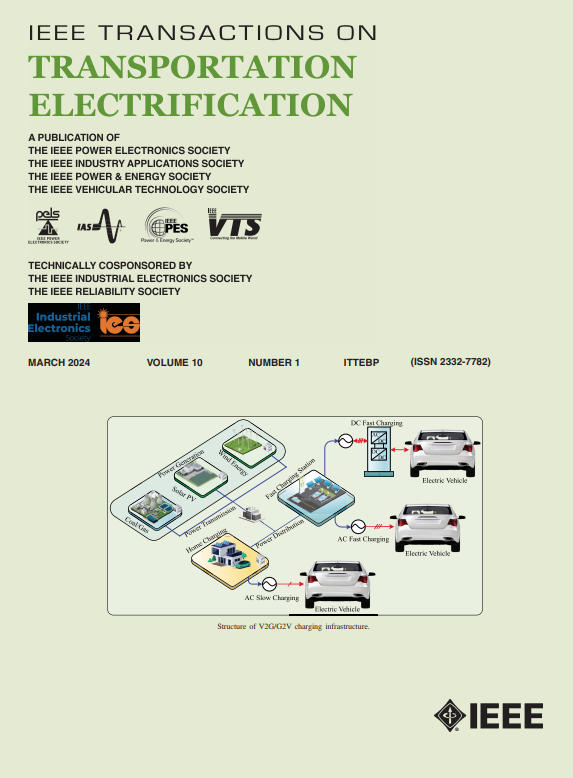An MPC Strategy for Anti-Pitch/Roll in Electric Vehicle Active Suspension Systems With Wheelbase Preview Information on Uneven Roads
IF 8.3
1区 工程技术
Q1 ENGINEERING, ELECTRICAL & ELECTRONIC
IEEE Transactions on Transportation Electrification
Pub Date : 2025-03-17
DOI:10.1109/TTE.2025.3551899
引用次数: 0
Abstract
On uneven roads, active suspension can effectively reduce road vibrations and shocks compared with passive suspension. In this context, a wheelbase preview-based model predictive control (PMPC) approach for anti-pitch/roll in electric vehicle active suspension systems (ASS) is proposed to enhance vehicle ride comfort and stability. First, a 7-DOF vehicle model and a road excitation model were established. This road excitation model can more comprehensively reflect the vehicle’s vibration, pitch, and roll states under different uneven roads. Next, considering the wheelbase preview information, an augmented prediction model that external disturbances are augmented as state variables is designed to improve the prediction accuracy. This augmented prediction model reduces the number of external disturbances while using feedforward information of the disturbances to provide a more accurate prediction of the vehicle’s motion states. Then, based on the modified predictive model, we propose an model predictive control (MPC) method for electric vehicle ASS that considers disturbance feedforward information. The suppression of the vehicle’s vertical acceleration, pitch acceleration, and roll acceleration is set as the objective function, with disturbance feedforward information used as the predicted output. Meanwhile, the suspension dynamic deflection, tire dynamic load, and actuator constraints are considered. Finally, the proposed controller is tested via co-simulations with CarSim and MATLAB/Simulink, and a hardware-in-the-loop (HIL) system. The results demonstrate that the controller effectively improves vehicle comfort and stability on various levels of uneven roads in both the time and frequency domains.基于轴距预览信息的不平路面电动汽车主动悬架抗俯仰/侧倾MPC策略
在凹凸不平的路面上,与被动悬架相比,主动悬架能有效减少路面振动和冲击。在此背景下,提出了一种基于轴距预览的电动汽车主动悬架抗俯仰/侧倾模型预测控制方法,以提高车辆的平顺性和稳定性。首先,建立了7自由度车辆模型和道路激励模型;该路面激励模型能更全面地反映车辆在不同不平路面下的振动、俯仰和侧倾状态。其次,考虑轴距预览信息,设计了以外部扰动为状态变量的增广预测模型,提高了预测精度;这种增强的预测模型减少了外部干扰的数量,同时利用干扰的前馈信息提供了对车辆运动状态更准确的预测。然后,在修正预测模型的基础上,提出了一种考虑扰动前馈信息的电动汽车自动系统模型预测控制方法。以抑制车辆垂直加速度、俯仰加速度和侧倾加速度为目标函数,以扰动前馈信息作为预测输出。同时考虑了悬架动挠度、轮胎动载荷和作动器约束。最后,通过CarSim和MATLAB/Simulink以及硬件在环(HIL)系统的联合仿真对所提出的控制器进行了测试。结果表明,该控制器在时域和频域上均能有效提高车辆在不同高低不平路面上的舒适性和稳定性。
本文章由计算机程序翻译,如有差异,请以英文原文为准。
求助全文
约1分钟内获得全文
求助全文
来源期刊

IEEE Transactions on Transportation Electrification
Engineering-Electrical and Electronic Engineering
CiteScore
12.20
自引率
15.70%
发文量
449
期刊介绍:
IEEE Transactions on Transportation Electrification is focused on components, sub-systems, systems, standards, and grid interface technologies related to power and energy conversion, propulsion, and actuation for all types of electrified vehicles including on-road, off-road, off-highway, and rail vehicles, airplanes, and ships.
 求助内容:
求助内容: 应助结果提醒方式:
应助结果提醒方式:


